- Chronology
- Before 1500 BCE
- 1500 BCE to 500 BCE
- 500 BCE to 500 CE
- Sixth to Tenth Century
- Eleventh to Fourteenth Century
- Fifteenth Century
- Sixteenth Century
- Seventeenth Century
- Eighteenth Century
- Nineteenth Century
- Twentieth Century
- Twenty-first Century
- Geographic Area
- Africa
- Caribbean
- Central America
- Central and North Asia
- East Asia
- North America
- Northern Europe
- Oceania/Australia
- South America
- South Asia/South East Asia
- Southern Europe and Mediterranean
- West Asia
- Subject, Genre, Media, Artistic Practice
- Aesthetics
- African American/African Diaspora
- Ancient Egyptian/Near Eastern Art
- Ancient Greek/Roman Art
- Architectural History/Urbanism/Historic Preservation
- Art Education/Pedagogy/Art Therapy
- Art of the Ancient Americas
- Artistic Practice/Creativity
- Asian American/Asian Diaspora
- Ceramics/Metals/Fiber Arts/Glass
- Colonial and Modern Latin America
- Comparative
- Conceptual Art
- Decorative Arts
- Design History
- Digital Media/New Media/Web-Based Media
- Digital Scholarship/History
- Drawings/Prints/Work on Paper/Artistc Practice
- Fiber Arts and Textiles
- Film/Video/Animation
- Folk Art/Vernacular Art
- Genders/Sexualities/Feminisms
- Graphic/Industrial/Object Design
- Indigenous Peoples
- Installation/Environmental Art
- Islamic Art
- Latinx
- Material Culture
- Multimedia/Intermedia
- Museum Practice/Museum Studies/Curatorial Studies/Arts Administration
- Native American/First Nations
- Painting
- Patronage, Art Collecting
- Performance Art/Performance Studies/Public Practice
- Photography
- Politics/Economics
- Queer/Gay Art
- Race/Ethnicity
- Religion/Cosmology/Spirituality
- Sculpture
- Sound Art
- Survey
- Theory/Historiography/Methodology
- Visual Studies

In spring 1963, Art Journal,1 published by the College Art Association (CAA), featured a new section, entitled “Dissertations in Progress.”2 It was introduced by a brief caveat that described the list as “tentative and incomplete” while promising that it would be augmented in future issues (Fig. 1). At that time, the editors of the journal could not have foreseen that this particular feature, which included dissertations being written at only five universities, would remain a persistent yet greatly expanded offering among CAA’s publications for decades, eventually migrating to The Art Bulletin and then caa.reviews. Now organized by an expanded system of categories, this list includes the dissertations of almost all the art historians who have been trained in the United States over the past six decades. However, it has escaped critical notice as an institutional endeavor with its own history. In fact, CAA’s dissertation roster was first compiled at a time when the organization’s membership worried that there were not enough qualified art historians to fill the rising need for such professionals in North American universities. Today, that equation is reversed. Art history PhD holders have now grown far beyond the limited ranks included in that initial roster, while humanities programs contract, along with the availability of full-time academic positions.3 The CAA dissertation roster serves as a site to explore this shifting professional context of art history.
Here I examine the formation of the roster in 1963 and highlight certain changes that have been implemented to it since that time. One of the most important shifts took place in the year 2000, when the roster began to appear on CAA’s digital platform and thus became available for computational exploration on a larger scale. Drawing from this resource, this essay captures a collective profile of art history through data about newly completed PhDs, thereby exemplifying an inquisitive approach that is distinct from more conventional forms of art historical argumentation. As such, this investigation, which relies upon collaboration with a computer scientist and aims for reproducibility, suggests a viable tool kit that may hold potential for future research about the history of art history as a discipline.

The Beginnings of the Dissertation Roster
The CAA dissertation roster did not begin as an organized or rigidly defined endeavor. The list that appeared in 1963 was two pages long and included submissions from Princeton, Columbia, Harvard, Yale, and New York University. Each entry provided only the name of the PhD student and the title of the proposed dissertation. Of these five institutions, Yale’s list was further subdivided into sections that differentiated the projects based on their stage: “Completed,” “In Preparation,” and “Plans Pending.”4 As promised at the outset, addenda to the original list appeared in the autumn 1963 and autumn 1964 issues of Art Journal, with entries from Johns Hopkins, the University of Michigan, Indiana University, and the University of Paris, in addition to notices of ongoing research projects at other institutions.5 There was no defined process or fixed format for submission at this early stage. As such, in spring 1965, Charles Mitchell, of Bryn Mawr College, requested that three dissertations from his institution be added to the list in a letter to the editor of Art Journal (Fig. 2).6
Even with its supplements, the initial list became outdated quickly. So in summer 1968 a more definitive and updated seven-page roster, entitled “Doctoral Dissertations in Art History,” was issued, featuring projects completed since 1960 along with those in progress from fourteen institutions.7 An introduction stated that the information had been “solicited . . . from the graduate schools in art history in the United States which are known to us” and gave a mild rebuke to the programs that did not respond in time to be included (Fig. 3). It was also acknowledged that entries from the new programs that had just launched would be added later, which points to the expansion that the field of art history was witnessing at that time. The editors also expressed the aspiration to include dissertations being written in Canada and Europe in the future. In terms of format, this list was divided first by institution and then subdivided by completion status. Of the institutions featured, only Columbia further broke down its list of dissertations in progress by subfield, the first time that subject matter categories appeared on the roster. Over the next three years, supplements, some lengthy and others including only a few entries, were published in every issue or every other issue of Art Journal.

In three years yet another update appeared, entitled “Doctoral Dissertations in Art: A Recent Survey,” which had been gathered by John R. Spencer, vice president of CAA.8 Indeed, during this time, academic programs were solicited directly and the responsibility for generating the list rotated among the officials and members of the organization.9 The autumn 1971 roster was similar in length to the previous one, while its scope was much wider, with twenty-four doctoral institutions listed. Like the summer 1968 roster, it was divided first by institution and then by dissertation status, sometimes along with other information. For instance, Harvard subdivided its in-progress entries based on subfield, while also providing the name of the adviser or advisers for each area of study. It appears that the list had by this time achieved some status among the readership of the journal, for Columbia included a postscript to its own roster apologizing to those who may have been left out (Fig. 4).10 This preemptive explanation suggests that PhD students aspired to be included on the dissertation roster, which had achieved an authoritative status only eight years after its first appearance. In the following years, the editors of Art Journal attempted to solve the problem of updating the list by providing supplements that included only newly initiated projects, under the title “Dissertations-in-Progress.”11
A major shift occurred in winter 1973–74, when “Dissertations-in-Progress” was categorized by subfield, instead of the institutional rubrics that had been used for a decade. Many of these areas were grouped together, as follows: “Ancient Near East, Greek, Roman Art and Archaeology,” “Early Christian, Byzantine and Medieval,” “Renaissance: Northern and Italian,” “Baroque and Eighteenth Century,” “Nineteenth and Twentieth-Century European Art,” “American,” “Architecture and Planning: Renaissance to Present,” “East Asian,” “Iconography,” and “Miscellaneous.”12 Institutions were noted for each entry, set off by parentheses. A short postscript indicated that German and British dissertations were being tracked in the journal Kunstchronik, the publication of record for the Association of German Art Historians, which suggests that Art Journal had abandoned the previously expressed wish to integrate international projects.13 In spring 1974, the dissertation list moved toward further standardization and a fixed format for reporting, with the request that each entry be submitted with the following items: “institution, advisor, general area of dissertation.”14

In spring 1975, the format that continues today was essentially codified with a full roster of dissertations that had been completed, along with those in progress.15 Entries were listed under the relevant subfield, with the names of the adviser and institution. From that point forward, yearly rosters were issued, usually in the spring issue. However, in the autumn/winter 1980 issue of Art Journal, the roster concluded with a brief note: “In the future, the Dissertations Listing will appear in The Art Bulletin.”16
New PhDs for a Growing Job Market
The CAA dissertation roster began in 1963 and progressively developed until 1975, when the fixed format that is still used today was introduced. This institutional endeavor must be situated within the wider publication context of the periodicals issued by CAA. Since its beginnings, The Art Bulletin has served as the publication of record for CAA, presenting scholarly research essays in art history, an identity that it still maintains.17 Widely regarded as the organization’s “second journal,” Art Journal had a mission and purview that were, by contrast, “revamped, rehauled, and repackaged numerous times” in its history, as described by Craig Houser.18 It was first named Parnassus (1929–41) and then College Art Journal (1941–60) before being rebranded and relaunched under its current title in 1960. In its earliest stage, the content of Art Journal was mixed, including scholarly articles and book reviews that addressed art and architecture of various subfields and periods; features about pedagogy and issues of professional concern for artists and art historians; obituaries; and official news about the organization, such as the annual meeting program (now the CAA Annual Conference). As such it was, at least initially, a fitting venue for the dissertation roster. In 1980, it was decided that Art Journal would take on a thematic approach, with each issue overseen by a guest editor.19 This was likely the reason why the dissertation roster migrated to The Art Bulletin in that year. Its current focus on contemporary art was established in the late 1990s, when the thematic approach was eventually phased out. Since then, Art Journal’s readership and popularity have surpassed that of The Art Bulletin, thereby overturning its original subordinate status.20
The dissertation roster’s emergence must also be located amid a set of prevailing concerns about the environment for teaching the arts in North America.21 In 1966, the organization published a study called The Visual Arts in Higher Education (VAHE), which was based on research undertaken in 1961 and 1962 and funded by the Ford Foundation.22 It presented data about the state of art history instruction, enumerating that there had been 453 art history PhDs completed in the United States since 1930 and that 258 students were enrolled in graduate programs at that time, along with information about their areas of specialization and career paths.23 These efforts at garnering statistics clearly served as the inspiration for Art Journal’s dissertation roster, which then assumed this continuing task moving forward. Notably, the VAHE concluded that there was a dearth of qualified art historians to fulfill nationwide instructional needs. The editor, Andrew Ritchie, declared, “College enrollments are mounting at an alarming rate, but most departments of art history are not attracting or producing a sufficient number of well-trained graduates to meet the present shortage of teachers in the field.”24 This backdrop is crucial to understanding the emergence of the CAA dissertation roster, which was established amid an undersupply of PhDs as the field, along with the broader landscape of higher education in the United States, was witnessing rapid expansion.25
As an organization, CAA was founded in the early twentieth century, when North American universities were just beginning to grant doctoral degrees in art history. But, by the 1960s, many new programs were being established and needed freshly minted PhDs to fill their academic ranks. As such, the dissertation roster must also be connected to CAA’s placement services, which had been offered to members as early as 1940 but were expanded in 1977, when the organization started to offer standards for faculty searches and consolidated parts of the hiring process at the annual meeting, in addition to issuing a listing of positions, which later became the newsletter CAA Careers.26 While, as Julia A. Sienkewicz describes, the “surfeit of art history positions” indicated in the VAHE had begun to recede in the 1970s, it was during this time that the dissertation roster was reordered in format—listed by subfield rather than by institution—a change that could clearly serve the needs of hiring committees seeking candidates for positions in particular subject areas.27
Migration to The Art Bulletin
When the dissertation roster first appeared in The Art Bulletin in June 1981, a brief note acknowledged that this list had previously been published in Art Journal and provided guidelines for inclusion.28 Students were invited to submit new or substantially revised dissertation titles directly to the CAA office, indicating that this process was now being handled by the CAA staff, rather than designated appointees among its leadership. In its new home, the list continued the standardized format that Art Journal had eventually adopted. The roster was generally divided into the two categories of dissertations, completed and in progress, which were then further broken down by subfield.29 Each entry listed the name of the doctoral student, the title of the dissertation, the institution, and the name of the adviser or advisers. For the next twenty-seven years, this roster appeared in the June issue of The Art Bulletin, including the dissertations that were completed, in progress, or begun during the previous calendar year.30
Even if this roster had achieved a certain amount of consistency in format, some concerns remained unresolved, such as the inclusion of international titles. The 1982 and 1983 rosters repeated the caveat that had first been delivered in 1971, that Kunstchronik was publishing its own list of British and German dissertations, perhaps as a response to members who requested the inclusion of projects that were being carried out across the Atlantic.31 But the place of Canadian dissertations was still unsettled. In the 1985 roster, the title changed from “Dissertation Topics” to “American and Canadian Dissertations.”32 But then, in the 2000 roster, the title was redefined starkly as “U.S. Dissertations.”33 The title went back and forth between the two options a couple times before becoming fixed as “US and Canadian Dissertations” in the 2003 roster, a title that has been sustained to this day. Another issue of concern for the CAA staff was the problem of duplication. In their guidelines, students were frequently reminded that they should only resubmit a dissertation title if it was new or substantially changed from a previous entry or if the dissertation was completed, in order to avoid the appearance of the same project in multiple issues of the journal.34 However, this rule was eventually relaxed. Since the 2000 roster, all dissertations in progress are reported yearly, which has resulted in a much longer list with many entries repeated from year to year.35
The roster’s subfield categories have been subject to periodic change, related to larger overarching questions about how the various areas that constitute art historical work are defined and delimited. These issues have become more vivid as the field has expanded outside of its traditional limits and aimed for a more inclusive profile. In the early issues of The Art Bulletin, the dissertation subfield categories that were inherited from Art Journal generally continued. For example, the 1984 roster of dissertations that were begun in the previous year included categories that were similar to those of the 1970s: “Egyptian, Ancient Near Eastern, and Classical Art,” “Early Christian, Byzantine, and Medieval Art,” “The Renaissance,” “Baroque and 18th-Century Europe,” “19th- and 20th-Century Europe,” “Art of the United States (except Native American and Photography),” “Photography and Film,” “Native American, Pre-Columbian, and Latin American Art,” and “Art of Asia.”36 For most of the 1980s and into the 1990s, these categories were fairly stable. Slight modifications were made to them, usually in order to accommodate the appearance of particular entries that did not fit into the existing rubrics. For instance, in that 1984 roster, the category of Native American art was extracted from the subfield “Art of the United States,” to be grouped with pre-Columbian and Latin American topics. This change was implemented, it seems, to account for three dissertations begun on Lakota, Zuni, and Haida art.37 Islamic art did not appear as its own category until the 1992 roster and occupied an arbitrary position until then. For instance, in the 1986 roster, the category of “19th- and 20th- Century Europe” was expanded temporarily to “19th- and 20th-Century Europe and the Near East,” seemingly to include one completed dissertation on an Ottoman topic.38 More frequently, Islamic art dissertations appeared under the heading “Asian Art,” which was not always suitable, as demonstrated when a dissertation on Islamic Spain was listed in this category.39 Other examples include the appearance of “Art of the Pacific” in the 1993 roster and “African Diaspora” as separate from “African Art” in the 1994 roster, both added to accommodate a single entry.40 Most of these examples indicate the complexities in representing fields of art history outside of the long-standing, and largely Western-oriented, rubrics, as well as the question of how granular or focused these subject headings should be.
These categories began to shift in more structurally significant ways beginning in the 1990s, responding (albeit belatedly, in many cases) to larger transformations in the field. For instance, “Art Criticism and Theory” appears as a new category under “Dissertations Begun in 1989.”41 Contemporary art was first singled out only in the 1997 roster, with the category “Post–World War II American and European Art.”42 In this case, the newly added designation recognized research that was long in the works, for its initial listings included seven completed dissertations and twenty-nine that were begun the previous year. It was then renamed “Post-1945 Art” in the 2000 roster, “Post-1945 World Art” in the 2002 roster, and finally “Contemporary Art” in the 2003 roster. The 2002 roster also ushered in new and redefined categories oriented around media, such as “Material Culture,” “Architectural History,” and “Photography, Film, and Digital Media.”43 With the 2003 roster, the list was entirely overhauled to include a more extensive breakdown that is discussed below. In June 2008, The Art Bulletin featured its final dissertation roster, with twenty-nine subfields. It was thirty-three pages long.
The Dissertation Roster Online
Beginning with the 2000 roster, the dissertation list was also published simultaneously on CAA’s website.44 At that time program coordinators, rather than the students themselves, were asked to compile and submit lists for each institution.45 After the 2007 roster was issued in The Art Bulletin, the list migrated completely to the online format. It is fitting that it now appears in caa.reviews, which was established in 1998 as CAA’s first fully digital publishing endeavor.46 This platform is devoted to reviews of books and exhibitions, although other features and essays, such as this one, also appear in it. The section entitled “Dissertations” occupies its own tab, separate from the other content. Even in its digital form, the roster retains the general structure that had been adopted by Art Journal in 1975. The list is divided by subfield and then further split between dissertations completed and in progress. In the list’s online form, one can view the spectrum of fields quite easily while also toggling fluidly between the completed and in-progress dissertations for any single category. The caa.reviews dissertation listing began in 2009, when rosters dating back to 2002 were added.47 This listing is updated with the previous year’s entries on an annual basis.48 The most recent update was provided in 2019 for the year 2018.
In July 2020, the data comprising records of dissertations completed from 2002 to 2018 was harvested computationally from the caa.reviews roster and then cleaned, tidied, restructured, and analyzed.49 The following paragraphs reveal some initial results from this study. However, this exploration is preliminary and presented in order to spark interest in the possibilities of this data set, even to entice others to begin to work with it. As such, the tools that were used to carry out this analysis have also been published and documented.50 They include the Python script that was used to harvest the data, written by Kenneth Chiu; the cleaned data set that was used for analysis; and the R markdown file (a document format combining plain text with chunks of code in the R programming language) that was used to generate the following visualizations. It is hoped that these instruments will be taken up by others who may wish to ask particular questions oriented around specific subfields, individual institutions, or a different set of concerns. Indeed, the goal is to suggest a reproducible workflow that may extend into the future, as the roster continues to be updated and new questions about it emerge. It is acknowledged that this data set is incomplete, in that the reporting institutions inevitably overlooked some projects that were eligible for inclusion and in certain instances or years did not submit a roster to CAA at all. As such there are notable lacunae, along with inevitable errors that originated at the time of submission or from data entry. Indeed, this essay endeavors to identify what the CAA data set shows along with an understanding of what it cannot reveal. With these limitations in mind, the following visualizations may help us to understand certain patterns that are not apparent when the dissertation roster is viewed in its standard format as a list.
The CAA dissertation roster from 2002 to 2018 yielded 3,924 unique entries. Plotted by completion year, Figure 5 indicates that the number of dissertations finished in any given year generally oscillated between 200 and 250. The years 2010 and 2013 each witnessed an unusually high number of dissertations, 279 and 275, representing a functional ceiling in the number of degrees that have been issued in recent years. By contrast, 2011 was the lowest year during this time span, with fewer than 200 dissertations completed. As comparison, in 1966, the VAHE had estimated the average number of art history PhDs produced each year by decade as follows: 4 in the 1930s, 6 in the 1940s, 17 in the 1950s, and 26 in the 1960s.51

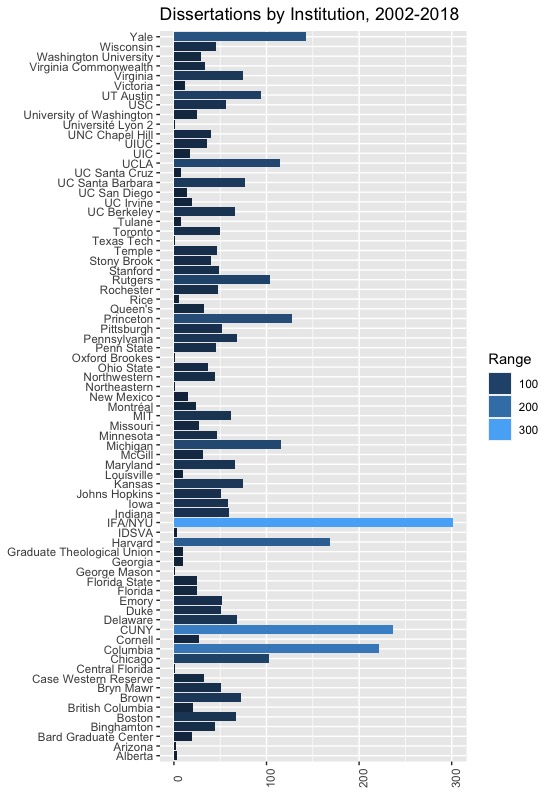
Fig. 6 Dissertations by Institution, 2002–2018 (graph by Nancy Um; click for larger version)
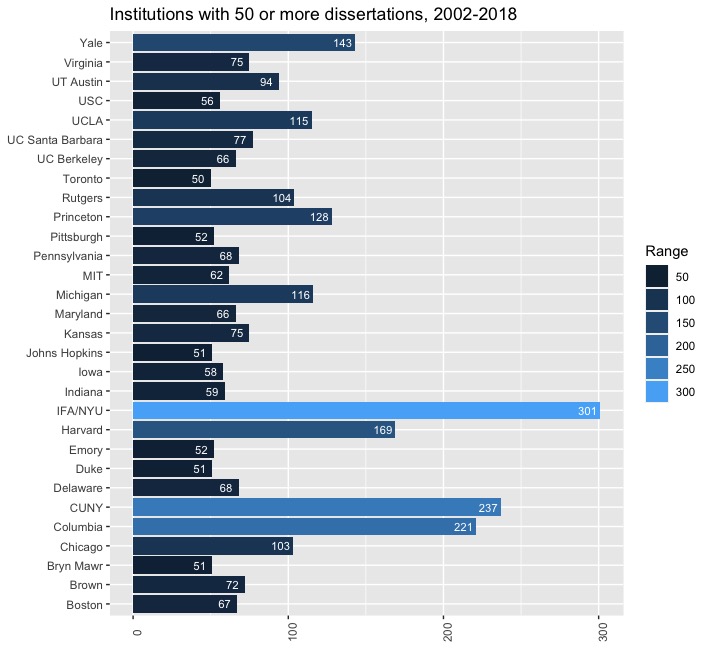
Based on the information provided in these rosters, it is possible to ask questions that are more individualized regarding advising and mentorship. For example, 958 names were listed as primary supervisors for the 3,924 dissertations over this time period.52 Of them, only 20 served as the primary adviser for 17 or more dissertations, which amounts to one dissertation completed per year (Fig. 8). The late Linda Nochlin of IFA/NYU and Mark Jarzombek of MIT appear as the most generative doctoral advisers in the United States, having supervised 33 and 27 dissertations respectively. This data set could be filtered and then queried by institution for a more granular look at a particular program examined over the course of time.
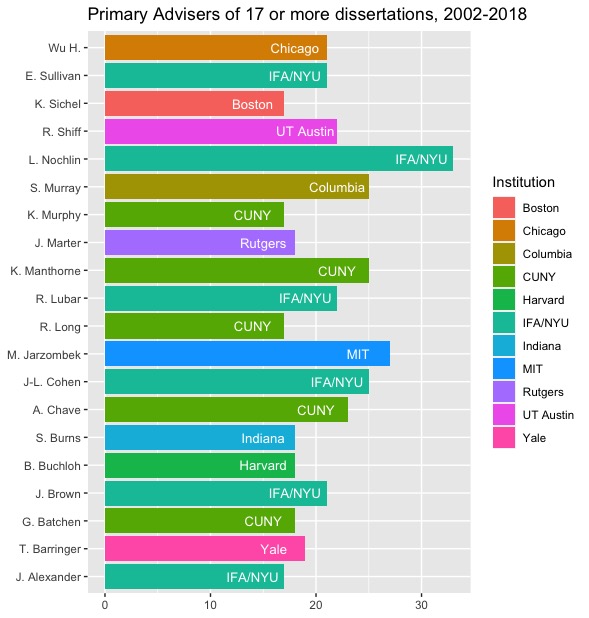
The question of subject matter must be approached through different methods, such as an exploration of the most commonly occurring terms that appear in recent dissertation titles (Fig. 9).53 Among the top terms, unsurprisingly, “art” appears most frequently, in 943 titles. The next most frequent terms, appearing more than 200 times each, are “American” (286), “architecture” (265), and “painting” (205), in addition to more generic terms, such as “century” (364) and “early” (227). The next group of terms, which appear more than 100 times, include “contemporary” (124), “culture” (179), “history” (127), “identity” (159), “modern” (186), “photography” (131), “politics” (126), and “visual” (161). They suggest the continuing interest in certain types of historic media, such as architecture, painting, and, to a lesser degree, photography, while also pointing to the modern and contemporary orientation of the field. In the next category of terms, which appear fewer than 100 times, certain area-specific designations, such as “France,” “medieval,” “Renaissance,” “Rome,” and “Roman,” appear. Elizabeth Mansfield, of Penn State University, is also in the process of working with the CAA dissertation data set, including the associated abstracts, which will allow for a more substantive exploration of content and subject matter in the future.
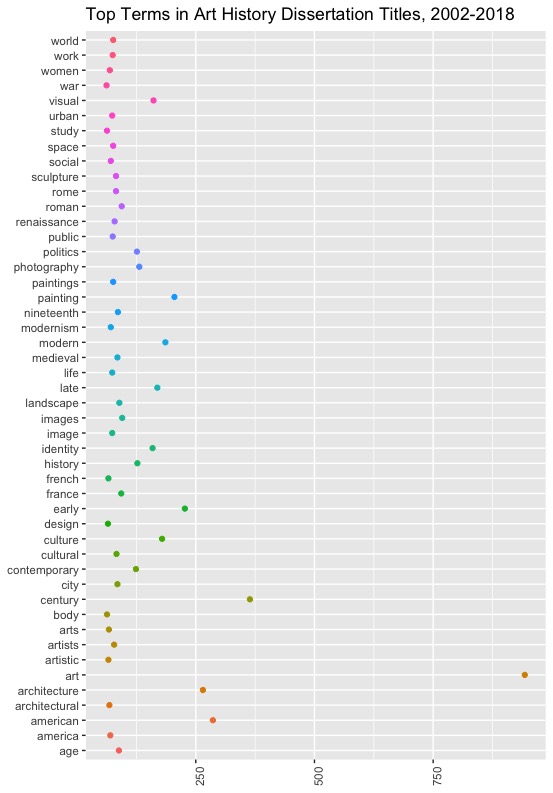
Then in 2015, yet another transformation was implemented, but this one resulted in a major structural shift, which posited three types of categories: Chronology, Geographic Area, and Subject, Genre, Media, Artistic Practice.56 In order to achieve a sense of balance, chronological designations were defined by the century or a time span across centuries, and geographic area designations were based on continents or subcontinental regions. As such, certain labels, such as “Renaissance/Baroque Art” or “Early Medieval/Romanesque/Gothic Art,” were altogether abandoned. So, a dissertation about the artist Raphael that would have been considered “Renaissance/Baroque Art” before 2015 is now reported under the categories “Sixteenth Century” or “Southern Europe and Mediterranean” instead. At the same time, a wide array of topics appears under the vast grouping Subject, Genre, Media, Artistic Practice, including certain media designations, such as “Sculpture,” and fields of study, such as “Art Education/Pedagogy/Art Therapy.” Notably, certain subfields, such as “Ancient Greek/Roman Art,” “African American/African Diaspora,” “Islamic,” and “Colonial and Modern Latin America” also appear under this heading, although not all subfields are included. Open-ended topical categories, such as “Comparative,” “Politics/Economics,” and “Race/Ethnicity,” were also added. As such, the CAA categories are highly variable and inconsistent over time, making it difficult to explore the trajectory of a specific subfield through the CAA dissertation roster. As an example, when plotted along the lines of geography, it appears as if European topics are in the minority. This misrepresentation originates from the fact that before 2015, Europe was frequently assumed as a default category and thus most European dissertations were marked not by geography but by temporal focus or medium. By contrast, dissertations about Africa, Asia, or Latin America, were almost always defined by geographical area and, as such, appear to be more numerous than those on European topics.
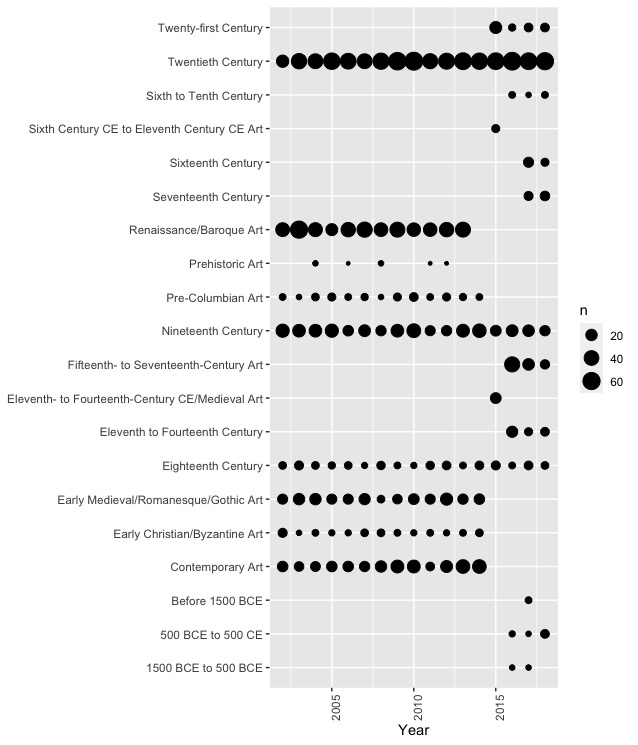
Even so, it is worthwhile to explore the changing categories that CAA has used over time, as they point to some of the shifting conceptions about the shape of the field of art history and its parts. Figures 10, 11, and 12 represent the various categories as they changed over the seventeen-year period.57 Figure 10, which focuses on chronology, indicates that certain subfields have had more longevity than others, such as “Eighteenth Century,” “Nineteenth Century,” and “Twentieth Century,” which outlasted those that were based on periodization, such as “Renaissance/Baroque Art” or “Prehistoric Art.” Under geographic area, in Figure 11, “African” and “South Asia/Southeast Asian” are the only categories that are reported consistently across the seventeen-year spectrum. Others, such as those related to Latin and Central America and the Caribbean, have been redefined much more dynamically in recent years. As apparent in Figure 12, categories such as “Sound Art,” “Latinx,” and “Queer/Gay Art” appear in 2015, which was also when “Design History” received its own category, having previously been associated with the category “Decorative Arts.” The dots on these three visualizations are sized by volume, but they do not necessarily indicate the scaled rise or fall of a particular subject over time for the reasons mentioned above. Rather, they should be used to understand the qualitative shifts in categorization and conceptualization of art historical areas. Particularly, Figure 12 indicates changing notions, some subtle and others marked, about which areas may be considered as tethered together and how those areas may be named. Indeed, the CAA dissertation roster points to debates that have been taken up amply through other forms of scholarly expression over the past six decades, regarding the scope of the field and the parts that compose it.
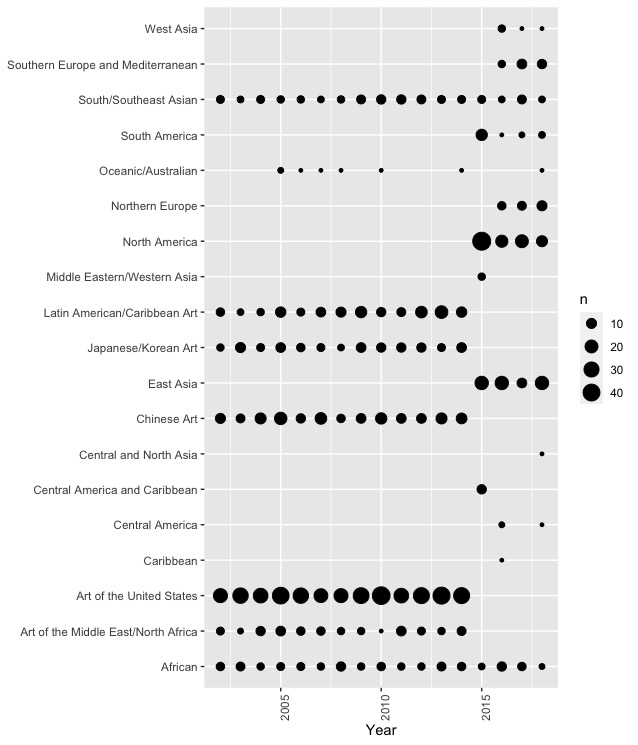
Fig. 11 Dissertation Categories Based on Geographic Area (graph by Nancy Um; click for larger version)
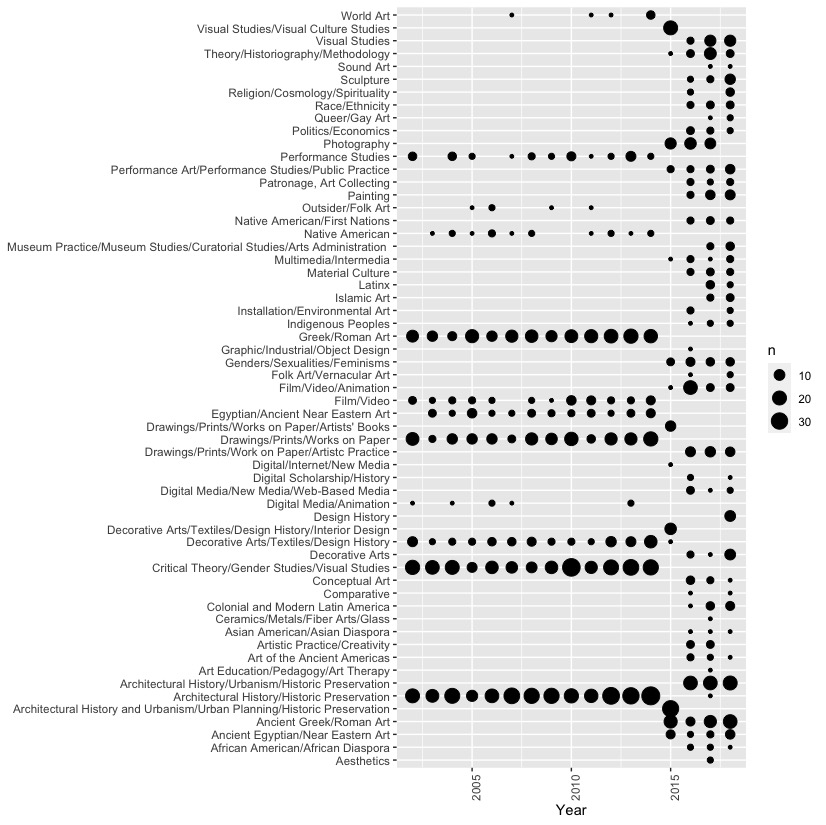
Fig. 12 Dissertation Categories Based on Subject, Genre, Media, Artistic Practice (graph by Nancy Um; click for larger version)
Dissertations Looking Forward
Even if the CAA dissertation roster has maintained a certain structural integrity since 1975, the context of its publication has changed progressively as it migrated across CAA’s print and digital publication platforms. It was first issued in 1963 at a moment when the field was rapidly widening. Today, in the year 2020, we sit in a very different position, shrouded by questions about the future of the humanities and the arts, which are driven by an economy of scarcity and an atmosphere of crisis. It is also worth noting that the process of hiring for academic positions is no longer oriented around CAA’s Annual Conference, as it had been in the early years of the dissertation roster, so those linked processes have been effectively severed. Meanwhile, new formats for remote interviewing have become standard and are poised to become even more pervasive in this age of social distancing.
It is hoped that this article will signal the richness of these records for future investigation. As mentioned above, a research team at Penn State is also working with the dissertation roster and aims to incorporate the earlier lists, beginning with 1980, which will allow for a longer view of some of these questions. Moreover, particular subfields or institutions could be queried intensively for more pointed examinations.58 This essay responds to a rising interest in the changing shape of academia that is relevant to other disciplines as well. Recent and ongoing studies take up questions of job placement, career trajectory, and gender, race, and ethnicity, relying on the results of surveys, data from ProQuest, and other methods, suggesting potential directions for future study that could also be used for the CAA dissertation data.59
(Click here to read part 2 of this essay, including enhanced data expanded to 1980.)
Nancy Um
Binghamton University
Notes
1 I thank the members of the CAA staff, past and current, who kindly offered assistance with this project: Joe Hannan, Betty Leigh Hutcheson, Daniel Tsai, Vanessa Jalet, Susan Ball, and Eve Sinaiko. Both former and current editors-in-chief of caa.reviews, Rick Asher, Juliet Bellow, and Julie Nelson Davis, provided valuable encouragement and feedback on the revision of this essay. My colleague Kenneth Chiu of Binghamton University wrote the Python script that was used to harvest the data from caa.reviews and served as a valued collaborator on this essay.
2 “Dissertations in Progress,” Art Journal 22, no. 3 (Spring 1963): 168.
3 Bryan Alexander, Academia Next: The Futures of Higher Education (Baltimore: Johns Hopkins University Press, 2020), 36–60.
4 “Dissertations in Progress,” Art Journal 22, no. 3 (Spring 1963): 169.
5 “Dissertations,” Art Journal 23, no. 1 (Autumn 1963): 94; “Dissertations in Progress,” Art Journal 24, no. 1 (Autumn 1964): 38, 104.
6 “Letters to the Editor: Doctoral Dissertations,” Art Journal 24, no. 3 (Spring 1965): 284.
7 “Doctoral Dissertations in Art History,” Art Journal 27, no. 4 (Summer 1968): 398–405.
8 “Doctoral Dissertations in Art: A Recent Survey,” Art Journal 31, no. 1 (Autumn 1971): 121–27.
9 “Dissertations-in-Progress,” Art Journal 32, no. 3 (Spring 1973): 384.
10 “Doctoral Dissertations in Art: A Recent Survey,” Art Journal 31, no. 1 (Autumn 1971): 122.
11 “Dissertations-in-Progress,” Art Journal 32, no. 3 (Spring 1973): 384.
12 “Dissertations-in-Progress,” Art Journal 33, no. 2 (Winter 1973/74): 180, 182.
13 Ibid., 182.
14 The “general area of dissertation” referred, perhaps, to the published headings that appeared in that issue, although they were not exactly consistent with the ones used in the previous year. “Dissertations-in-Progress,” Art Journal 33, no. 3 (Spring 1974): 286; “Dissertations Listing,” Art Journal 34, no. 3 (Spring 1975): 286.
15 The dates of completion were not specified. “Dissertations Listing,” Art Journal 34, no. 3 (Spring 1975): 286, 288, 290.
16 “Dissertations Listing,” Art Journal 40, no. 1/2 (Autumn/Winter 1980): 441.
17 Craig Houser, “The Changing Face of Scholarly Publishing: CAA’s Publications Program,” in The Eye, the Hand, the Mind: 100 Years of the College Art Association, ed. Susan Ball (New York: College Art Association; New Brunswick, NJ: Rutgers University Press, 2011), 48–49.
18 Ibid., 67.
19 Ibid., 77.
20 Ibid., 80–81.
21 Matthew Israel, “CAA, Pedagogy, and Curriculum: A Historical Effort, an Unparalleled Wealth of Ideas,” in Ball, The Eye, the Hand, the Mind, 169.
22 Andrew C. Ritchie, ed., The Visual Arts in Higher Education: A Study Prepared for the College Art Association of America under a Grant from the Ford Foundation (New York: College Art Association, 1966), ix.
23 Ibid., 4, 15.
24 Ibid., xii.
25 Ibid., 24, 38. The concerns that were expressed in the VAHE also prompted an expansion of CAA’s foundational mission statement. See “The Purposes of CAA,” Art Journal 22, no. 2 (Winter 1962/63): 71, 91.
26 CAA Careers was established in 1991. In August 2003, job postings were moved online. Ofelia Garcia, “Mentoring the Profession: Career Development and Support,” in Ball, The Eye, the Hand, the Mind, 130–31, 133.
27 Julia A. Sienkewicz, “Uniting the Arts and the Academy: A History of the CAA Annual Conference,” in Ball, The Eye, the Hand, the Mind, 106, 114.
28 “Dissertation Topics, 1980,” Art Bulletin 63, no. 2 (June 1981): 347–49.
29 Initially, after the move to The Art Bulletin, the completed dissertations were not divided by subfield; only those in progress were. With the 1983 roster, the list begins to divide both categories by subfield.
30 As a single exception, the 1987 roster was published in the fall of 1988. “American and Canadian Dissertations, 1987,” Art Bulletin 70, no. 3 (September 1988): 536–40.
31 “Dissertation Topics, 1982,” Art Bulletin 65, no. 2 (June 1983): 354; “Dissertation Topics, 1983,” Art Bulletin 66, no. 2 (June 1984): 355.
32 “American and Canadian Dissertations,” Art Bulletin 68, no. 2 (June 1986): 349–52.
33 “U.S. Dissertations, 2000,” Art Bulletin 83, no. 2 (June 2001): 367–82.
34 For example, see the introductory section for the 1982 roster: “Dissertation Topics, 1982,” Art Bulletin 65, no. 2 (June 1983): 354.
35 “U.S. Dissertations, 2000,” Art Bulletin 83, no. 2 (June 2001): 367.
36 The categories for dissertations in progress are not always identical to those used for the dissertations completed in the same year, as was the case for the 1984 roster.
37 “Dissertation Topics, 1984,” Art Bulletin 67, no. 2 (June 1985): 351.
38 “American Dissertations, 1986,” Art Bulletin 69, no. 2 (June 1987): 316.
39 “American and Canadian Dissertations, 1990,” Art Bulletin 73, no. 3 (September 1991): 520.
40 “American and Canadian Dissertations, 1993,” Art Bulletin 76, no. 2 (June 1994): 383; “American and Canadian Dissertations, 1994,” Art Bulletin 77, no. 2 (June 1995): 353.
41 “American and Canadian Dissertations, 1990,” Art Bulletin 73, no. 3 (September 1991): 520.
42 “American and Canadian Dissertations, 1997,” Art Bulletin 80, no. 2 (June 1998): 404, 408.
43 “U.S. and Canadian Dissertations, 2002,” Art Bulletin 85, no. 2 (June 2003): 413, 419.
44 It first appeared under the listing for The Art Bulletin on CAA’s publications webpage, but by 2005 it was moved to its own independent heading, “United States and Canadian PhD Dissertations.” “Publications,” CAA, March 2, 2000 and October 25, 2005, accessed at https://web.archive.org/web/20000302152727/http://www.collegeart.org/caa/publications/index.html; https://web.archive.org/web/20051029094056/http://www.collegeart.org/publications/.
45 “Dissertation Submission Guidelines,” caa.reviews, accessed June 7, 2020, http://www.caareviews.org/about/dissertations.
46 Houser, “The Changing Face,” 84.
47 At that time, the earlier rosters added to caa.reviews were formatted according to the 2009 standards, so they do not match their counterparts in The Art Bulletin exactly. Eve Sinaiko, email message to author, July 22, 2020.
48 “Dissertations,” caa.reviews, May 4, 2009, accessed at https://web.archive.org/web/20090504202205/http://www.caareviews.org/dissertations.
49 Dissertations in progress were not studied for this article, although the caa.py script could be modified to harvest and consider those listings as well.
50 Available for consultation and reuse in GitHub: https://github.com/nancyum/caa.
51 Ritchie, Visual Arts in Higher Education, 17.
52 For each entry, the first adviser mentioned is noted as the primary adviser. Although the entries could include up to four advisers, only 215 listed more than a single adviser.
53 The titles were cleaned lightly, only to correct typos and errors. Stop words (commonly occurring words that are frequently filtered out for natural language processing) were omitted.
54 The first time that such categories were introduced by the organization was in 1955, referred to as the “Checklist of Fields of Specialization.” Garcia, “Mentoring the Profession,” 131.
55 The most recent guidelines limit each dissertation to two subject areas.
56 “Dissertation Submission Guidelines,” caa.reviews.
57 Figures 10, 11, and 12 were plotted using the complete data set with all its duplicates, which includes 5,681 entries. “Dissertation Submission Guidelines,” caa.reviews. Identical categories, such as “Eighteenth Century” and “Eighteenth-Century Art,” were reconciled, while similar yet distinct categories were retained in order to show the subtle changes in nomenclature and grouping. For instance, see the shifts in the categories related to Architectural History, Decorative Arts, and Drawing in Figure 12.
58 As one example, see Nancy Um, “A Field without Fieldwork: Sustaining the Study of Islamic Architecture in the 21st Century,” International Journal of Islamic Architecture 10, no. 1 (forthcoming).
59 “Data on the History Profession,” American Historical Association, accessed June 6, 2020, https://www.historians.org/jobs-and-professional-development/career-resources/data-on-the-history-profession; “The SAH Data Project: Analyzing Architectural History in Higher Education,” accessed June 6, 2020, https://www.sah.org/publications-and-research/sah-data-project; Bas Hofstra et al., “The Diversity-Innovation Paradox in Science,” Proceedings of the National Academy of Sciences of the United States of America 117, no. 17 (April 28, 2020), https://www.pnas.org/content/117/17/9284.


